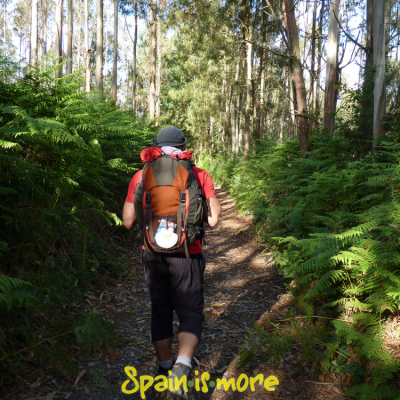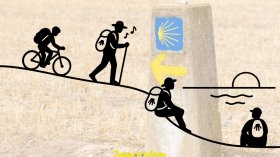
Create your own journey; Experience the best of Northern Spain at your own pace
This website uses its own and third-party cookies, for the proper functioning of the site and to generate usage statistics.
By continuing to browse we understand that you consent to our �ookie policy
The Camino Inglés (the English Camino) to Santiago was the route originally used by the Brittish and pilgrims arriving to Spain by boat from Northern Europe. This Camino begins in Ferrol and ends in Santiago de Compostela. A scenic and very authentic route packed with history.

Pilgrimage from Ferrol to Santiago: History and cultural heritage
Throughout Medieval times, the Jacobean pilgrimage enjoyed widespread popularity. Seafaring pilgrims from Scandinavia, Flanders (the Netherlands,) England, Scotland and Ireland all made their way to destinations such as Ribadeo, Viveiro, Ferrol and A Coruña. As a result of its location, the 118 km. stretch linking Ferrol to Santiago was extremely popular.
Pilgrimages from Scandinavia and the British Isles began in the 12th century. One of the most noteworthy episodes involving the pilgrims occurred in 1147, with the arrival of a squadron of crusaders on their way to the Holy Land. This squadron took part in the conquest of Lisbon, aiding the first king of Portugal in his struggle against the Muslims. Before facing the belligerent opposition, crusaders from England, Germany and Flanders would visit the tomb of St. James.
The first maritime account recorded between 1154 and 1159 by the Icelandic monk, Nicholas Bergson, describes the voyage from Iceland to Bergen (Norway), Aalborg (Denmark), and Vyborg (Russia), sailing down the Kiel Canal that marks the border between Denmark and Germany. On his way to the Holy Land, this monk continued on foot to Rome. In addition, Icelandic and Scandinavian pilgrims travelling to Santiago took this maritime route to Denmark, continuing their journey on foot to Roncesvalles, or by boat to the north of the Iberian Peninsula.
During the Hundred Years War that raged between France and England during the 14th and 15th centuries, the British used boats to travel to ports in the Northern Spain and from there to Santiago de Compostela. The vessels that were chartered for this purpose would set sail, with permission from the Crown, from London, Bristol, Southampton, and Plymouth, ultimately returning to England loaded with goods from Galicia. The presence of these pilgrims in Santiago is well documented by ceramic pieces and coins dating from the 14th and 15th centuries, found during excavations in the cathedral.
Other traces of seafaring pilgrimages can be found in the offerings made to St. James. The most outstanding is the famous portable alabaster altarpiece depicting the life of the Apostle, which was donated to the cathedral of Santiago de Compostela in 1456 by Father John Goodyear, a parish priest of the church of Chale on the Isle of Wight (diocese of Winchester). This work of art, part of the collection of the Cathedral Museum, portrays five scenes in the life of the Apostle: his vocation, his preaching in Hispania, his martyrdom in Palestine and the transportation of his remains by boat to Galicia. Another splendid offering related to the pilgrimages undertaken from the British Isles is the "pearl cross". This relic, crafted in gold and silver, displaying enamel work and studded with pearls and gems, was created in Paris between 1375 and 1400 and donated by King James IV of Scotland (1475-1513). The divorce of Henry VIII (1509-47) from Catherine of Aragon caused him to break ties with the Catholic Church, thus bringing an end to the pilgrimages from England.
Whether they were noblemen, princes, clergymen or laymen, pilgrims found refuge in the hospitals along the English Way. From Ferrol to A Coruña, the route was less arduous, thanks to the services provided by the religious order of the Sancti Spiritus. Starting in the 14th century, the Franciscan Order opened the doors of their dwellings in Pontedeume and Betanzos, under the auspices of the nobleman, Fernan Perez de Andrade, "O Bo".
Along this stretch, which headed out from Ferrol, there were pilgrim hospitals run by the hospitalers of the Sancti Spiritus located in Ferrol, Neda, Mino, Paderne and Betanzos. Another pilgrim hospital dedicated to San Lorenzo was founded in Bruma, in 1140, becoming part of the Hospital of Santiago in 1175. In the A Coruña stretch, the city offered pilgrims accommodation run by the religious orders of Los Angeles, Santa Catalina and San Andres, and, as they proceeded along the Way, there were facilities in Sigras and Poulo. Some of these establishments had chapels and cemeteries, whose archives contain records of the deaths of pilgrims of English, Nordic, German, French and Italian origin. These records highlight the great historical importance of the Jacobean pilgrimages along this route.
Please contact Spain is more, we will be more than happy to help creating the itinerary most suitable for you on this antique Camino route.
Buen Camino!

Discover the 2025 rules for la Compostela. Learn requirements, stamps, and tips to get your pilgrim certificate on the Camino de Santiago.

Which section of the Camino is the easiest? Which Camino is the most beautiful? And where is it actually the hardest to walk?